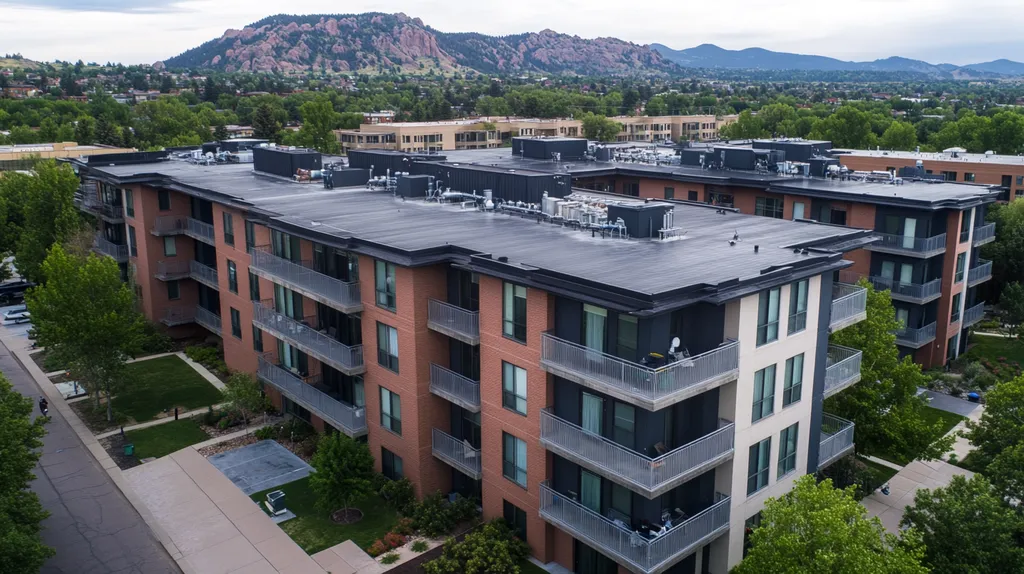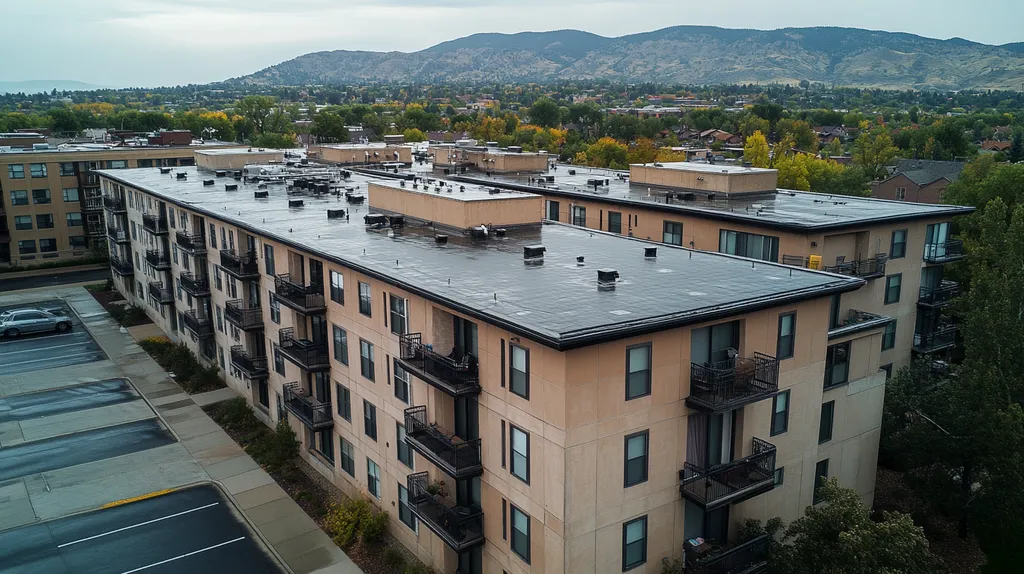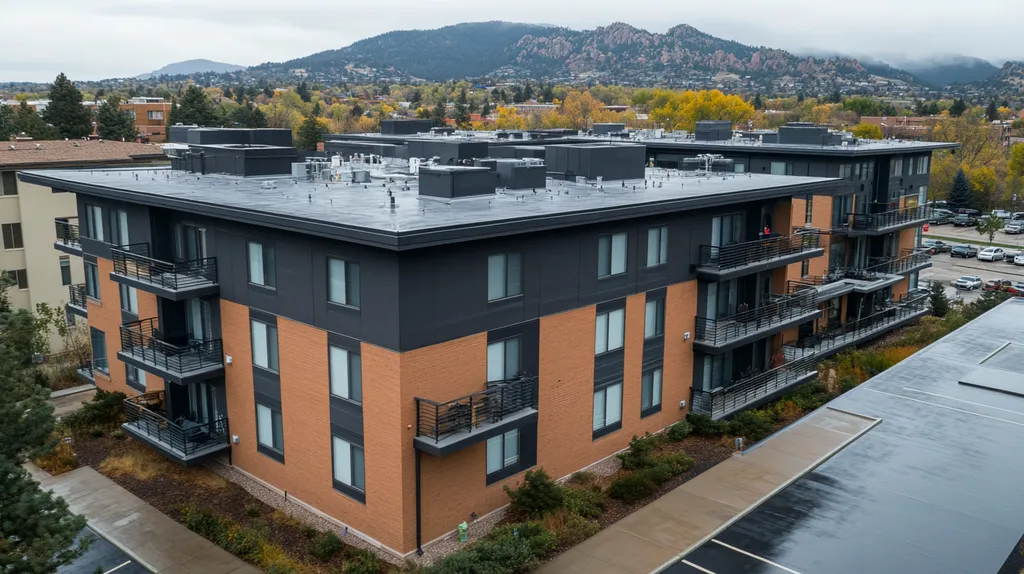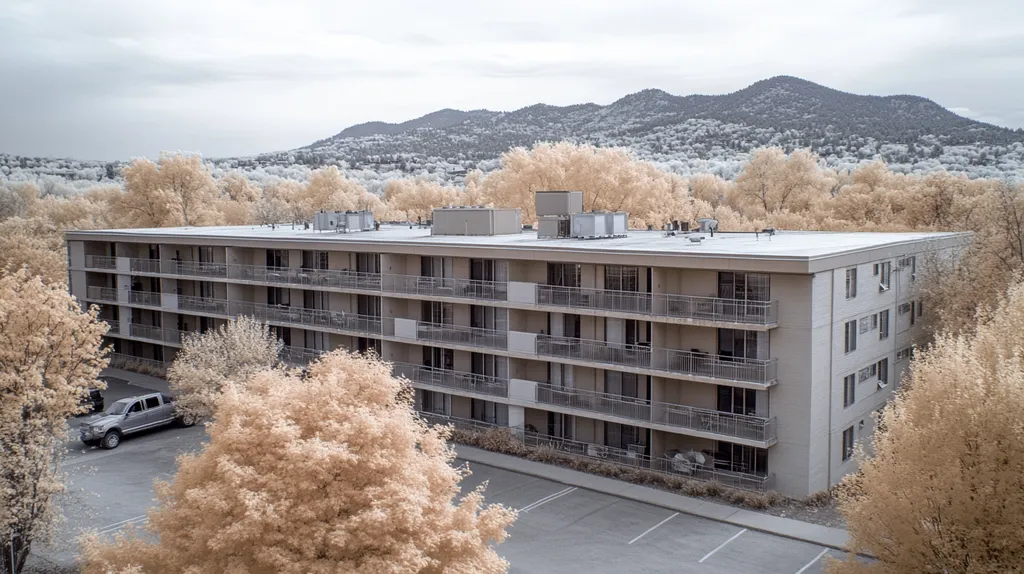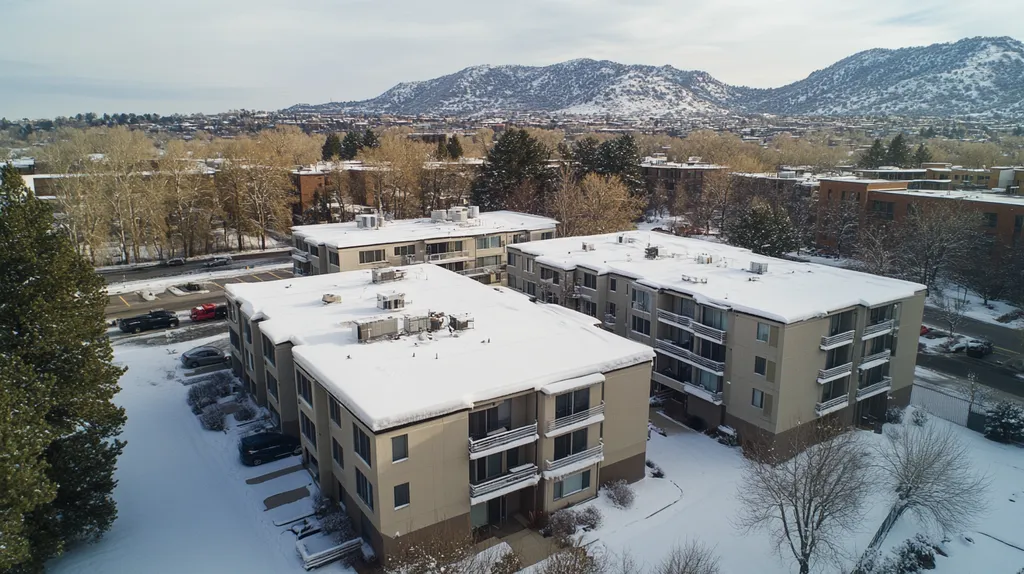Every year, over 50 workers lose their lives in preventable roofing accidents, with falls remaining the leading cause of construction-related fatalities. Beyond the human cost, inadequate safety measures expose facilities to multi-million dollar liabilities and catastrophic operational disruptions.
For industrial facilities, implementing proper roofing safety protocols isn’t just about regulatory compliance – it’s about protecting lives while safeguarding operational continuity. This comprehensive guide examines essential safety measures, from physical barriers to training protocols, that every facility manager must understand to prevent accidents and ensure compliance.
Through practical examples and industry standards, we’ll explore how to create, implement, and maintain effective safety systems that protect workers while preserving your facility’s bottom line.
SECTION 1: THE BASICS EXPLAINED
Every year, thousands of workplace accidents occur on industrial roofs, with falls remaining the leading cause of construction fatalities. Beyond the human cost, these incidents result in project delays, legal complications, and damaged reputations. Understanding and implementing proper safety measures isn’t just about compliance – it’s about protecting lives while safeguarding your facility’s operations and bottom line.
What It Is (In Plain Language)
Industrial roof safety measures constitute a comprehensive system of physical barriers, protective equipment, and standardized procedures designed to prevent accidents. These include warning lines, safety harnesses, guardrails, and clearly marked access points.
Warning line systems must be installed 6 feet from roof edges and include high-visibility markers every 6 feet. These lines must be positioned between 34 and 39 inches above the working surface and withstand at least 16 pounds of force. (source: OSHA)
Beyond physical equipment, safety measures include mandatory training programs, daily safety briefings, and weather monitoring protocols. These elements work together to create multiple layers of protection.
Every safety system requires a designated competent person to monitor compliance and respond to changing conditions throughout the project duration.
Why It Matters (To Your Building)
Proper safety measures protect more than workers – they safeguard your facility’s operational continuity. A single safety incident can shut down operations for days or weeks, creating costly ripple effects throughout your supply chain.
Insurance carriers closely scrutinize safety protocols when determining coverage and rates. Strong safety records often translate to lower premiums and better coverage terms.
Building owners face significant liability exposure for safety violations, even when working with contracted services. Courts regularly hold property owners partially responsible for workplace accidents.
Safety compliance also affects your ability to attract quality contractors. Top-tier roofing companies often decline projects where owners resist implementing comprehensive safety measures.
How It Works
Effective safety systems start with detailed site-specific safety plans that identify potential hazards and outline specific preventive measures. These plans must account for unique building characteristics, weather patterns, and operational constraints.
Implementation begins with installing physical safety equipment like warning lines, guardrails, and anchor points. Each component must meet strict engineering specifications and undergo regular inspection.
Daily operations require continuous monitoring and adjustment. Safety officers conduct regular walkthroughs, verify equipment condition, and ensure worker compliance with protective measures.
Communication systems keep all stakeholders informed of changing conditions or emerging hazards. This includes clear protocols for stopping work when unsafe conditions develop.
Documentation tracks all safety-related activities, from equipment inspections to worker training records. This creates an audit trail that demonstrates due diligence and supports potential insurance claims.
SECTION 2: PRACTICAL APPLICATIONS
Every industrial roofing project presents unique safety challenges that demand rigorous protective measures. Data shows that roof-related falls remain the leading cause of workplace fatalities in construction, with most incidents occurring due to inadequate safety systems. Understanding how and when to implement proper safety measures can mean the difference between project success and catastrophic failure.
Common Uses & Examples
Warning line systems represent the first line of defense in roof safety, requiring installation 6 feet from roof edges with high-visibility markers every 6 feet. These systems must maintain a height between 34-39 inches and withstand at least 16 pounds of force without failing. (source: OSHA)
Personal fall arrest systems provide critical backup protection, especially during maintenance and repair operations near roof edges. These systems include full-body harnesses, secure anchor points, and connecting devices that limit fall distance.
Guardrail systems protect workers around roof hatches, skylights, and other rooftop openings. Modern systems feature self-closing gates and non-penetrating bases that preserve roof membrane integrity.
Safety monitoring protocols complement physical barriers through designated safety officers who maintain constant surveillance of work areas and changing conditions.
When You Need It Most
Enhanced safety measures become critical during initial roof installation when multiple trades work simultaneously in confined spaces. These high-activity periods require careful coordination of access points, material staging, and worker movements.
Emergency repairs following severe weather events demand heightened safety protocols. Damaged roofing materials, unstable surfaces, and pressure to restore operations quickly create additional hazards requiring special attention.
Major renovation projects that expose large sections of the roof structure necessitate comprehensive fall protection planning. These projects often involve removing existing safety systems while installing new ones.
Routine maintenance operations near mechanical equipment or other rooftop obstacles require specialized safety configurations. Even experienced workers need proper protection when navigating these challenging areas.
Interactions With Other Systems
Safety measures must integrate seamlessly with lightning protection systems, ensuring fall protection anchor points don’t compromise lightning arrestors or conductors. This coordination prevents creating new hazards while addressing existing ones.
Rooftop mechanical systems require carefully planned safety measures that maintain both fall protection and equipment access. Strategic placement of permanent anchor points and guardrails ensures safe maintenance without impeding system operation.
Solar panel installations introduce additional complexity to roof safety systems. Warning lines and fall protection must account for panel layout while maintaining required clearances for maintenance access.
Building automation and security systems often interface with roof safety measures through access control points and emergency notifications. These interconnected systems help track worker presence and monitor safety compliance.
SECTION 3: KEY TERMINOLOGY DECODED
In industrial roofing, misunderstanding technical terms can have devastating consequences. Every year, preventable accidents occur because key safety specifications were misinterpreted or incorrectly implemented. Proper comprehension of roofing terminology directly impacts worker safety, project costs, and long-term facility protection.
Essential Terms Explained
Warning line systems represent a critical safety barrier that demands precise understanding. These systems must be installed 6 feet from roof edges with high-visibility markers placed every 6 feet, maintaining a height between 34-39 inches and withstanding 16 pounds of force. (source: OSHA)
Fall arrest systems include three essential components: anchorage points, body harnesses, and connecting devices. Each element must meet specific load ratings and installation requirements to ensure worker protection.
Parapet walls serve dual functions as fall protection barriers and water drainage control. Understanding minimum height requirements and structural specifications ensures these walls fulfill both safety and waterproofing roles.
Load ratings determine the maximum weight a roof section can safely support. This includes both dead loads (permanent weight) and live loads (temporary weight from workers, equipment, or environmental factors).
Industry Jargon Translated
Penetration flashings protect roof openings where pipes, vents, or equipment pass through the membrane. Proper installation requires understanding both the flashing material properties and compatibility with surrounding roofing components.
Membrane uplift resistance describes a roofing system’s ability to withstand wind forces. This specification directly impacts safety during maintenance operations and severe weather events.
Expansion joints accommodate building movement without compromising roof integrity. These specialized components require precise placement and ongoing monitoring to prevent structural stress.
Fire barriers segment large roof areas into smaller compartments, limiting potential fire spread. Understanding barrier requirements ensures proper installation and maintenance of these critical safety features.
Measurement & Units Simplified
Roof pitch measurements follow a standardized ratio format expressing vertical rise per 12 inches of horizontal run. This measurement impacts drainage patterns, safety requirements, and appropriate material selection.
Material thickness specifications use multiple measurement systems including mils, gauge, and millimeters. Converting between these units accurately ensures proper material selection and installation.
Coverage calculations utilize “squares” as the standard unit, with one square equaling 100 square feet. This measurement system helps determine material quantities and workforce requirements.
Load calculations combine multiple factors including equipment weight, snow loads, and maintenance traffic. Understanding these calculations prevents overloading and ensures long-term structural integrity.
SECTION 4: DECISION FACTORS
When evaluating industrial roofing safety measures, facility managers face critical decisions that directly impact worker safety and operational continuity. Falls remain the leading cause of construction fatalities, with inadequate safety systems contributing to over 30% of rooftop accidents. Every decision about safety equipment, protocols, and materials creates ripple effects throughout the facility’s operations, compliance status, and risk exposure.
Cost Considerations
Initial safety equipment costs typically represent 15-20% of a comprehensive roofing project budget. This investment includes physical barriers, personal protective equipment, and training programs essential for worker protection.
Insurance carriers closely evaluate safety measures when determining premiums. Strong safety protocols and properly maintained equipment often translate to reduced insurance costs and better coverage terms.
Emergency repairs and accident response can cost 10 times more than preventive safety measures. A single workplace incident often triggers multiple expenses including medical care, legal fees, and operational disruptions.
Proper documentation and maintenance of safety systems protect against costly regulatory fines. OSHA violations for inadequate fall protection can exceed $13,000 per incident, with repeat violations reaching $145,000.
Performance Trade-offs
Warning line systems must be installed 6 feet from roof edges with high-visibility markers every 6 feet. These systems require specific height placement between 34-39 inches and must withstand at least 16 pounds of force without failing. (source: OSHA)
Higher-quality safety equipment often delivers superior protection but requires more frequent inspection and maintenance. This increased maintenance schedule must be balanced against operational demands and access restrictions.
Weather-resistant materials and coatings can extend safety system lifespan but may limit compatibility with certain anchor points or mounting systems. These limitations require careful evaluation during initial system design.
Integration with existing roof structures sometimes forces compromises between optimal safety placement and practical installation constraints. Creative solutions must maintain protection levels while working within physical limitations.
Lifespan & Durability Factors
Safety equipment exposure to UV radiation, extreme temperatures, and chemical contamination accelerates deterioration. Premium materials and protective coatings can extend useful life by 40-50% compared to standard options.
Regular inspection schedules directly impact equipment longevity and reliability. Monthly visual inspections and quarterly detailed assessments help identify wear patterns before they compromise safety.
Anchor point installation methods affect both immediate safety and long-term roof integrity. Non-penetrating systems preserve membrane warranties but may require more frequent repositioning or replacement.
Material compatibility between safety equipment and roofing components influences system durability. Galvanic corrosion between dissimilar metals can compromise anchor points, while certain plastics may degrade when contacting roofing adhesives.
SECTION 5: COMMON CHALLENGES
Industrial roofing projects face multiple safety hurdles that can compromise worker protection and project success. Recent data shows that over 30% of construction fatalities stem from preventable rooftop accidents. From shifting weather conditions to equipment failures, these challenges demand vigilant attention and systematic solutions to ensure worker safety and maintain regulatory compliance.
Frequent Problems & Solutions
Warning line systems represent a critical safety component that demands precise implementation. These systems must be installed 6 feet from roof edges with high-visibility markers every 6 feet, maintaining 34-39 inches height and withstanding 16 pounds of force without failing. (source: OSHA)
Equipment deterioration poses significant risks, particularly in harsh environments. Regular inspections and immediate replacement of compromised components help maintain system integrity and worker protection.
Poor communication between trades often creates dangerous overlaps in work zones. Implementing digital coordination systems and mandatory safety briefings helps prevent conflicts and ensures clear accountability.
Material staging frequently creates temporary hazards by blocking safety systems or creating trip risks. Developing detailed logistics plans with designated staging zones helps maintain safe access routes throughout the project.
Warning Signs To Watch For
Physical damage to safety equipment often indicates deeper systemic problems. Regular inspections should examine not just visible wear but also mounting points and connection hardware.
Worker fatigue becomes evident through increased minor incidents and near-misses. Monitoring work patterns and adjusting schedules can prevent exhaustion-related accidents.
Weather-related deterioration of safety systems may accelerate suddenly. Changes in material color, flexibility, or tension often signal impending equipment failure.
Documentation gaps in safety logs suggest potential compliance issues. Missing inspection records or incomplete training certifications demand immediate attention and correction.
Preventative Approaches
Comprehensive site surveys before project initiation identify potential hazards and system requirements. These assessments should map all roof penetrations, edges, and equipment locations requiring protection.
Technology integration through digital monitoring systems provides real-time safety oversight. Modern solutions can track worker locations, equipment status, and environmental conditions simultaneously.
Cross-training programs ensure multiple workers can perform safety monitoring duties. This redundancy maintains protection levels during staff changes or emergency situations.
Documentation automation streamlines compliance tracking while reducing human error. Digital systems can generate inspection reports, maintenance schedules, and training records automatically.
SECTION 6: NEXT STEPS & RESOURCES
Industrial roofing safety represents a complex intersection of regulatory requirements, risk management, and operational efficiency. With roofing accidents accounting for nearly 40% of construction-related fatalities, implementing proper safety measures isn’t optional – it’s essential for survival. Understanding how to evaluate providers, interpret standards, and access learning resources creates the foundation for maintaining safe, compliant roofing operations.
Questions To Ask Providers
Pre-task safety briefings represent a critical first step in hazard prevention. Every roofing project should begin with a detailed 5-10 minute discussion of specific hazards, work area conditions, and required permits. (source: SafetyCulture)
Request detailed documentation of the provider’s safety training program, including certification records and ongoing education requirements. Top-tier contractors maintain comprehensive digital records of all safety certifications and regular skills assessments.
Examine the provider’s equipment inspection and maintenance protocols. Quality contractors perform daily equipment checks and maintain detailed logs of all safety gear inspections, repairs, and replacements.
Verify the provider’s incident response procedures and communication protocols. Leading contractors maintain clear chains of command and documented procedures for handling everything from minor incidents to major emergencies.
Industry Standards & Guidelines
OSHA regulations establish minimum requirements for fall protection, personal protective equipment, and safety monitoring systems. These standards specify exact measurements for warning lines, guardrail heights, and anchor point strength ratings.
The National Roofing Contractors Association (NRCA) provides detailed technical guidelines that often exceed OSHA minimums. Their recommendations incorporate lessons learned from actual workplace incidents and emerging safety technologies.
Factory Mutual (FM) Global standards outline specific requirements for roof system performance under various conditions. These guidelines help ensure safety measures remain effective even during severe weather or emergency situations.
Local building codes frequently contain additional safety requirements based on regional conditions. Understanding these jurisdiction-specific regulations prevents compliance gaps that could compromise worker protection.
Further Learning Simplified
Digital learning platforms offer on-demand access to safety certification courses and continuing education modules. These resources allow facility managers to stay current with evolving safety standards while maintaining operational flexibility.
Professional associations provide specialized training focused on specific roofing systems and safety challenges. These programs often include hands-on components that build practical skills alongside theoretical knowledge.
Industry conferences and workshops deliver opportunities to examine new safety technologies and best practices. These events facilitate direct interaction with equipment manufacturers and safety experts.
Peer networking groups enable facilities professionals to share experiences and solutions around common safety challenges. These communities often maintain active online forums for real-time problem-solving support.
The Bottom Line
With over 50 preventable roofing fatalities occurring annually, implementing comprehensive safety measures isn’t optional – it’s imperative for survival in today’s industrial environment.
Warning line systems, fall protection equipment, and rigorous training protocols form the foundation of effective roof safety, but they’re only as strong as their implementation and maintenance.
Facility managers who prioritize safety through proper equipment selection, regular inspections, and documented compliance protect more than workers – they safeguard their operations from costly shutdowns, legal liability, and reputational damage.
The stakes are clear: investing in robust safety measures today prevents catastrophic losses tomorrow while ensuring regulatory compliance and operational continuity for years to come.
FREQUENTLY ASKED QUESTIONS
Q. What are the basics of commercial roof safety measures?
A. Safety measures include physical barriers, protective equipment, and standardized procedures to prevent accidents. They involve elements like warning lines, safety harnesses, and guardrails that enhance worker protection while ensuring operational efficiency.
Q. When should safety measures be enhanced during industrial roof projects?
A. Enhanced safety measures are especially critical during initial installations, emergency repairs, and major renovations. These activities often involve higher risks and require careful coordination to protect workers and maintain compliance with safety regulations.
Q. What key terminology should I understand regarding industrial roof safety?
A. Key terms include warning lines, fall arrest systems, and load ratings. Understanding these definitions helps ensure proper implementation of safety protocols, which can prevent accidents and improve overall project outcomes.
Q. What decision factors impact safety measures for commercial roofs?
A. Key factors include cost considerations, performance trade-offs, and lifespan durability of safety equipment. Each decision affects worker safety and compliance, so it’s crucial to weigh all options carefully throughout the roofing project.
Q. What are common challenges faced in industrial roofing safety?
A. Common challenges include equipment deterioration, poor communication among teams, and material staging hazards. Addressing these issues proactively through inspections and coordination can enhance safety and reduce project disruptions.
Q. What next steps should facilities managers take for roofing safety?
A. Facilities managers should evaluate safety providers, understand industry standards, and access learning resources. These steps enhance safety measures and ensure compliance with evolving regulations and best practices in roofing safety management.
Q. How do environmental factors affect industrial roof safety?
A. Environmental factors like weather conditions and temperature variations can significantly impact safety equipment performance. Regular assessments and adjustments are necessary to ensure that safety measures effectively mitigate risks posed by environmental changes during roofing projects.

